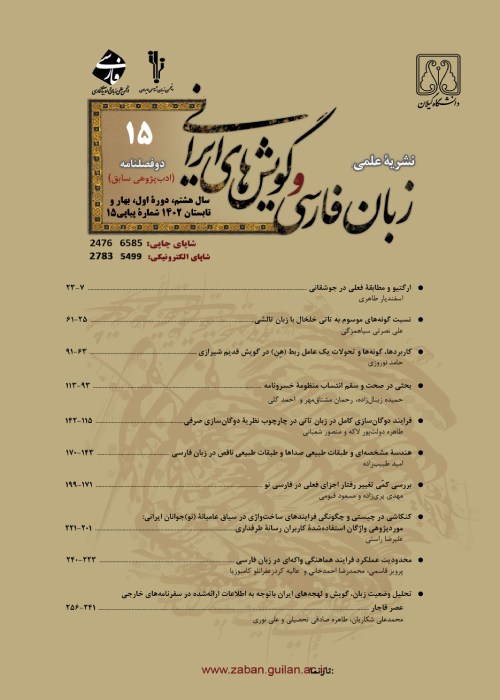A Quantitative Study of The Change in The Behavior of The Verbal Particles in The New Persian
The verb particles of the verb phrases in Persian were simple verbs in which new role don't have their primary meaning. The purpose of this research is to identify what verbs in New Persian have gone through this passage, which ones have been more stable in the language, and also which ones have had strong tendencies to have new roles in Persian verb phrases. For this, we have used a quantitative statistical criterion called “coefficient of variance”. This parameter creates a new ranking for verbs, which shows a numerical presentation of their behavioral changes. The results show that “zadan” has had the most behavioral change and “dāštan” has been the most stable verb particle.
Verb is one of the essential elements of sentence. Like the other linguistic components, verbs are also born, go through changes in their lifetime and then they may die or may have a longer lifetime. From one point of view, structurally, verbs can be classified into two general categories: simple verbs and verbs with complex structures. Generally, simple verbs, which are usually one word, have the same semantic content represented lexically. The primary goal of this paper is to investigate which verbs have been used as verb particles in the structure of modern Persian non-simple verbs in the last twelve centuries. Therefore, instead of the term “light verb” used for the verb component in compound verbs, the term “verb particle” has been used to include more verb constructions. Besides, this research seeks to identify verbs used as verb participles and find those verbs that have been continuously present during recent 12 centuries. Obviously, the frequency of verbs that have this condition is not the same. So, if we are looking for a quantitative measure for it, it is clear that frequency is not a suitable one. Therefore, another goal of this research is to provide a quantitative measure to determine which of these verbs, which have always been verb particle, have a growing tendency to change from simple verbs to verb participles, and which ones show almost constant behavior.
In order to observe language change, Paul Baker has done a corpus survey on English. His study deals with the concept of “lockwords”. A lockword is a word that may change its meaning or even use, but still have an approximately equal number in the corpus, especially in multi-part historical corpuses. The aim of Baker's research was to examine how English vocabulary has developed over the past eight decades. His main research questions were to identify words whose frequency was increasing, decreasing, or remaining constant over time relative to other words. He tries to provide acceptable explanations for such phenomena. Unlike previous studies, Baker was also interested in stability including which words have not changed much over time in recent English corpora.
Conducting this research required a historical corpus. This corpus contains 1200 pages of complete text, with 100 pages from each century as random samples. That is, 100 pages with 12 B Nazanin font have been selected from the texts of each century, excluding any type of paragraphing and punctuation marks. This body contains more than 1,000,000 words in total. But even with a text corpus, this research wouldn’t be completed. Rather, it was necessary to create a labeled body.
182 different verb participles were found in this corpus from which only 24 were used in all centuries. Their appropriate quantitative measure is the “coefficient of variance” that quantitatively determines their tendency during these centuries. Therefore, the frequency factor alone cannot show this trend accurately.
This research sought to find a quantitative measure to show which verbs have had a greater tendency to be used in more complicated verb structures, as well as in simple ones, from 10th century until now. First, we had to investigate which verbs participated in this process. Next, 182 verbs were found from which only 24 were continuously found in all centuries.
Therefore, the investigation was continued on these 24 verb components. Then, by examining the tools provided by statistics, a search was made to find the best measure to quantify the behavior of these verb components. According to Baker, neither the frequency nor the standard deviation was appropriate for this research, but the appropriate measure was the coefficient of variance. Based on the results obtained from this criterion, a new ranking of the behavior of the verb components in terms of participation in more complex constructions was obtained. In this ranking, the verb “zadan” showed the most tendency to participate in this type of verb constructions and the verb “dāštan” had the least change. That is, “dāštan” has always participated in these types of verb constructions in a stable way during these centuries. Therefore, it can be concluded that “zaden” has shown the most tendency to participate in more complex verb constructions and the verb “dāštan” is the most stable lockword in the verb class in New Persian.
- حق عضویت دریافتی صرف حمایت از نشریات عضو و نگهداری، تکمیل و توسعه مگیران میشود.
- پرداخت حق اشتراک و دانلود مقالات اجازه بازنشر آن در سایر رسانههای چاپی و دیجیتال را به کاربر نمیدهد.



